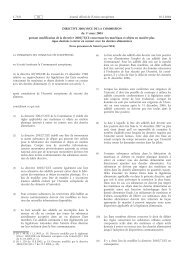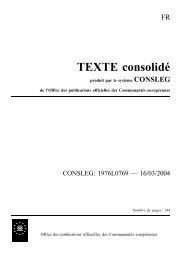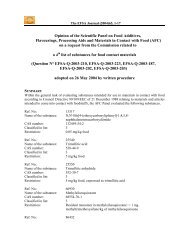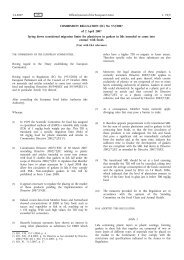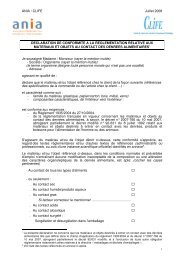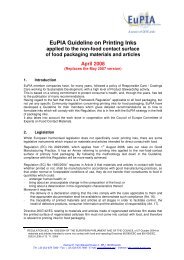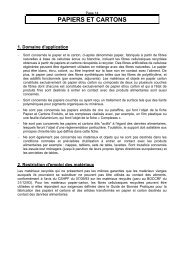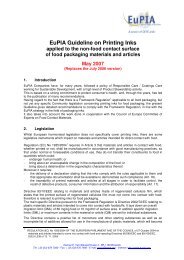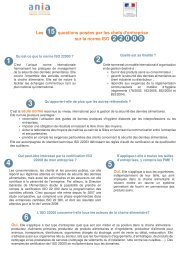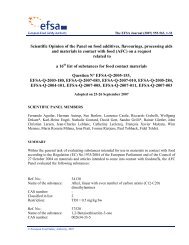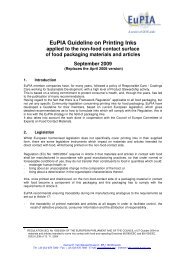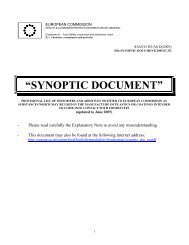Technical guidelines on testing the migration of primary aromatic ...
Technical guidelines on testing the migration of primary aromatic ...
Technical guidelines on testing the migration of primary aromatic ...
Create successful ePaper yourself
Turn your PDF publications into a flip-book with our unique Google optimized e-Paper software.
food simulant, depending <strong>on</strong> <strong>the</strong> type <strong>of</strong> food simulant. Thus <strong>the</strong> method is capable<strong>of</strong> quantitative detecti<strong>on</strong> <strong>of</strong> formaldehyde at a minimum level <strong>of</strong> 3,0 mg/kg foodsimulant.2 PROTOCOL BIn cases where <strong>the</strong> specific migrati<strong>on</strong> <strong>of</strong> formaldehyde exceeds <strong>the</strong> restricti<strong>on</strong>, e.g. aspecific migrati<strong>on</strong> <strong>of</strong> 15 mg/kg, <strong>the</strong> result <strong>of</strong> <strong>the</strong> determinati<strong>on</strong> shall be c<strong>on</strong>firmed.The c<strong>on</strong>firmati<strong>on</strong> procedure is quantitative. In collaborative trials with threelaboratories comparable results using <strong>the</strong> chromotropic acid method and <strong>the</strong> acetylacet<strong>on</strong>e method were found for <strong>the</strong> detecti<strong>on</strong> limits, repeatability, recovery andmigrati<strong>on</strong> <strong>of</strong> formaldehyde. Therefore <strong>the</strong> method <strong>of</strong> determinati<strong>on</strong> and <strong>the</strong>c<strong>on</strong>firmati<strong>on</strong> procedure are interchangeable.2.1 PrincipleFormaldehyde is reacted with pentane-2,4-di<strong>on</strong>e in <strong>the</strong> presence <strong>of</strong> amm<strong>on</strong>iumacetate to form 3,5-diacetyl-1,4-dihydrolutidine. The absorbance <strong>of</strong> this complex ismeasured at 410 nm with a spectrophotometer.2.2 Materials and chemicalsNOTE: Only additi<strong>on</strong>al chemicals required for <strong>the</strong> c<strong>on</strong>firmati<strong>on</strong> procedure are menti<strong>on</strong>ed2.2.1 Analytes and Chemicals2.2.1.1 Amm<strong>on</strong>ium acetate, anhydrous2.2.1.2 Pentane-2,4-di<strong>on</strong>e (acetyl acet<strong>on</strong>e), C 5 H 8 O 2 , distilled2.2.2 Soluti<strong>on</strong>s2.2.2.1 Pentane-2,4-di<strong>on</strong>e reagentThis reagent shall be freshly prepared <strong>on</strong> <strong>the</strong> day <strong>of</strong> use.Dissolve 15 g amm<strong>on</strong>ium acetate in a 100 ml volumetric flask c<strong>on</strong>tainingapproximately 75 ml <strong>of</strong> water. Add 0,2 ml pentane-2,4-di<strong>on</strong>e and 0,3 ml acetic acid.Make up to 100 ml with water (pH <strong>of</strong> soluti<strong>on</strong> about 6,4)2.2.2.2 Reagent without pentane-2,4-di<strong>on</strong>ePrepare <strong>the</strong> reagent soluti<strong>on</strong> while omitting <strong>the</strong> additi<strong>on</strong> <strong>of</strong> pentane-2,4-di<strong>on</strong>e.2.3 Procedure2.3.1 Preparati<strong>on</strong> <strong>of</strong> test samples2.3.1.1 For <strong>the</strong> determinati<strong>on</strong> <strong>of</strong> HMTATransfer into a 50 ml flask 10,0 ml <strong>of</strong> aqueous food simulant , add 5 ml <strong>of</strong> sodiumhydroxide soluti<strong>on</strong> (1.2.2.4) and 15 ml <strong>of</strong> water. Check <strong>the</strong> pH <strong>of</strong> <strong>the</strong> soluti<strong>on</strong>, and ifnecessary adjust to pH 4 to pH 6 using a few drops <strong>of</strong> sodium hydroxide soluti<strong>on</strong>54




